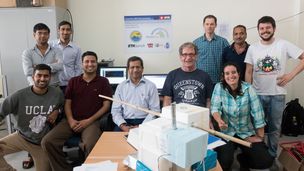
GCOS Reference Upper-Air Network
Stratospheric and upper tropospheric processes for better climate predictions (2016)
StratoClim (2016)
The StratoClim 2016 campaign took place from mid July until mid August 2016 in Nainital, India. Goal of the campaign was to study the exchange between the troposphere and stratosphere due to deep convection during the Indian Monsoon. During this campaign various in situ instruments were employed, including radiosondes, ozone sondes, CFH and COBALD; a substantial part of which was supplied by Lindenberg observatory. Furthermore, the GRUAN Lead Centre/Lindenberg Observatory contributed to the campaign in form of an experienced scientist (Peter Oelsner) to coordinate and assist the preparation and operation of the balloon-borne instruments during the campaign. Due to external circumstances the envisaged participation of the research aircraft "Geophysica" in the campaign was cancelled
so that the 2016 campaign was reduced to radiosounding activities only.
In addition to the scientific instruments, the payloads were expanded with RS92 and RS41 radiosondes, providing intercomparison data about the performance of both sonde models under tropical conditions, which are a valuable addition to the GRUAN-wide management of the RS92-RS41 transition. During the campaign, which was complemented with additional in situ soundings in November 2016, in total 33 CFH and RS92-RS41 intercomparison soundings were performed.
References
Brunamonti et al., Water Vapor in the Asian Summer Monsoon Anticyclone: Comparison of Balloon-Borne Measurements and ECMWF Data, 2019, https://agupubs.onlinelibrary.wiley.com/doi/abs/10.1029 /2018JD030000
Brunamonti et al., Balloon-borne measurements of temperature, water vapor, ozone and aerosol backscatter at the southern slopes of the Himalayas during StratoClim 2016-2017, 2018, https://www.atmos-chem-phys.net/18/15937/2018
